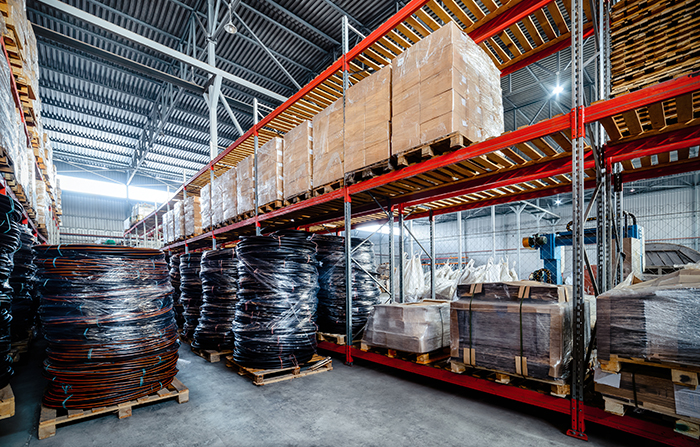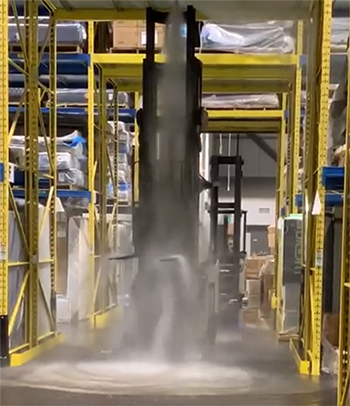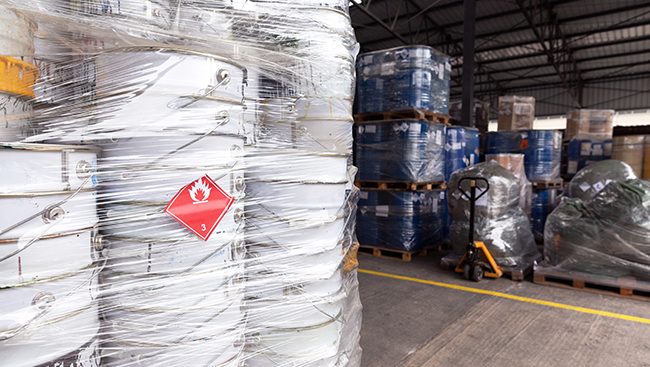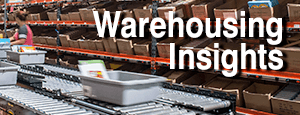Pallet Racks, Sprinkler Systems and Warehouse Fire Precautions
What can you do to reduce fire risks in your warehouse?

All warehouses have fire risks, ranging in severity. Facilities flammable loads like paper, aerosols, liquors or fiber are at higher risk than others, but any load on wood or plastic pallets can catch fire. For instance, manufacturing facilities with airborne debris are at more risk than those storing ceramics or steel components. While storage racks are not among leading causes of warehouse fires, (or even a cause, except for their loads) they can play an important part in reducing spread and damage.
Anyone who has implemented a large pallet rack installation can tell you that permitting tends to be complicated and may be delayed by fire permitting. City officials and approval boards frequently don’t know or understand code and how it pertains to rack systems, which can cause no end to problems as your project moves forward. A well-defined plan can save you significant time.
What causes warehouse and industrial fires?
National Fire Protection Association statistics tell us that 37,000 fires happen every year at industrial facilities, warehouses and manufacturing plants, which causes 18 deaths and 279 injuries along with over $1 billion in direct property damage. This doesn’t include indirect costs, such as lost business, time involved in litigation, insurance or rebuilding, which may exceed the direct damages.
The most common causes include electrical systems, heating, lighting, airborne debris, chemicals, arson and unclassified structural fires. If you’re storing anything combustible on your racks, fire suppression should always be a concern in your designs. Pallets are flammable, as are any packing materials, cartons, paper or fibers stored on pallet racks.
High-density storage lets you store more in less space, but also concentrates fuel and increases fire risks, so it’s important to design your warehouse storage racks with fire suppression in mind.

Design your rack system with fire prevention in mind
Right: a warehouse rack structure with integrated sprinkler struck by forklift mast. One thing to be aware of is the potential for damage if a sprinkler system is struck. Find ways to guard and train staff to avoid collisions while traveling, loading and unloading near fire prevention systems.
Overhead sprinkler systems
Overhead fire suppression systems that trigger by temperature are common in industrial facilities. In a high-bay warehouse, the problem with an overhead system is that it may not be able to penetrate the pallet rack due to high storage density or solid decks. Water may not penetrate much past the top layer of pallets. Solid decks will always block water from overhead systems, which makes the case for perforated or wire decking, which allow better water flow than boards or other types of solid deck.
Spacing between loads is also critical for overhead sprinklers. IFC codes suggest 6″ between pallets, which combined with wire decking will allow more water to reach lower beams and their loads.
A quick warehouse fire safety checklist:
- Know your load classification (Class I through Class IV and “high-hazard”)
- Install fire prevention systems (sprinklers, baffles, etc) in and near the rack
- Fire extinguishers should be accessible and easily located
- Have detailed and practiced evacuation plans
- Make sure your exit points are clearly marked and free of obstructions
- Any procedures local code or your internal safety experts advise
Please remember that these are general safety tips, and that any plans you make should include safety professionals and local code experts.
In-rack sprinkler systems
Some installations, operations and load types will need an in-rack fire suppression system. These tend to be ‘wet’ systems installed on one or more levels inside a pallet rack system. These systems are more targeted and can trigger for localized fires in the rack structure, which could minimize damage and cleanup across an entire warehouse.
It’s more logical and cost-effective to use an in-rack system when your operation is more at-risk for fires, when the inventory is particularly valuable and when it can withstand water damage. Hazardous, flammable, aerosol or explosive materials may require even more fire suppression measures. The goal is to reduce the damage as much as possible. These networks of water pipes will be added to your rack structure. They’re heat-activated and trigger when they reach a specified temperature.

Piled high loads
Many building code jurisdictions require “piled high” storage permits, which governs most high-bay warehouse storage racks. This International Fire Code standard states that a piled-high permit is needed for any storage of items higher than 12 feet for an area greater than 500 square feet. This standard may vary based on local fire codes, so you’ll need to check your area’s building standards.
The type of load can be rated on a scale of relative fire hazard, from Commodity ratings of Class I through Class IV, with the most flammable loads classified as high hazard commodities. Higher-risk loads like tires, some types of plastics, flammable liquids, and large quantities of pallets may require piled-high permits for stacks or rack storage 6 feet high. Even some packaging materials or plastic pallets can adjust the classifications.
Less flammable loads like ceramics or steel can still present fire hazards if stored on flammable pallets or packed with fibers, shredded paper, etc.
There are costs and complications associated with in-rack systems. In-rack systems must be maintained, and they will require detailed up-front planning, but are worth it for the right operation and load profile, operation and situation.
Channel flames up, not out
 One of the important principles is to contain damage. For a couple of reasons, you will want flames channeled up, not out. First, The fire may consume the stored items as it climbs and run out of fuel before spreading. Secondly, if your facility has an overhead sprinkler system, it will act on the flames more effectively if they climb rather than spread. To achieve this, you should design adequate space between loads in each bay and maintain both longitudinal and latitudinal flue space.
One of the important principles is to contain damage. For a couple of reasons, you will want flames channeled up, not out. First, The fire may consume the stored items as it climbs and run out of fuel before spreading. Secondly, if your facility has an overhead sprinkler system, it will act on the flames more effectively if they climb rather than spread. To achieve this, you should design adequate space between loads in each bay and maintain both longitudinal and latitudinal flue space.
Read more: The Importance of Pallet Rack Row Flue Space – and Ways to Maintain it. Also: Fire Codes and Pallet Rack Load Beams
Fire baffles
Fire baffles are flat or corrugated metal panels installed inside your rack structure designed to contain fire into a specific area. Baffles prevent fire from jumping between bays when installed vertically, and levels when stored horizontally. A vertical installation runs the entire height of each upright and can be engineered to fit your facility. Use baffles for high-risk fire loads (aerosols, chemicals, liquor, fabrics, paper/fiber) to help contain the fire within a defined area. Baffles may limit visibility within the rack system and may complicate loading in some installations.
Warehouse safety is always critical
Industry groups such as RMI (Rack Manufacturer’s Institute) participate in NFPA committees to ensure rack systems are built, designed and implemented with safety in mind. They help shape the standards that keep your warehouse safe. RMI certified racks meet the group’s rigorous manufacturing and safety standards. We believe every warehouse should be designed and built with a priority on safety, from storage to foot/forklift traffic to conveyance, to docks, doors and many other factors. For assistance, call us today.
More resources
- Protecting Forklifts and Their Loads
- Pallet Rack Falling Item Prevention
- Visibility for Forklift Drivers in Rack Aisles
Tags: Safety & Ergonomics
Scott Stone is Cisco-Eagle's Vice President of Marketing with 35 years of experience in material handling, warehousing and industrial operations. His work is published in multiple industry journals an websites on a variety of warehousing topics. He writes about automation, warehousing, safety, manufacturing and other areas of concern for industrial operations and those who operate them.



